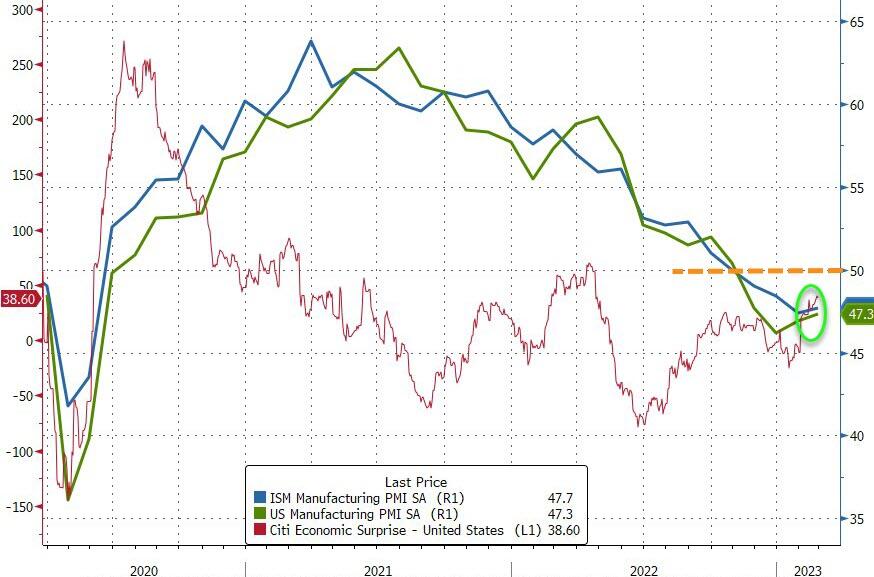The ISM Manufacturing PMI for the US jumped to 47.7 in February from 47.4 in the previous month, below analysts’ expectations of 48.0. Fresh report pointed to a fourth consecutive month of falling factory activity, after a 30-month period of expansion, with companies continuing to slow outputs to better match demand for the first half of 2023 and prepare for growth in the second half of the year.
New orders (47 vs 42.5) and backlogs of orders (45.1 vs 43.4) contracted at a slower pace and the customers’ inventories index remained at ‘too low’ levels (46.9 vs 47.4), a positive for future production. On the other hand, a bigger decline was seen in production (47.3 vs 48) while employment fell (49.1 vs 50.6) although companies continue to indicate that they will not substantially reduce head counts, as sentiment is positive about the second half of the year. At the same time, price pressures increased (51.3 vs 44.5), supporting agreement between buyers and sellers to place orders in the near term.
Earlier S&P Global Manufacturing PMI for the US was revised lower to 47.3 in February from a preliminary estimate of 47.8.
Chris Williamson, Chief Business Economist at S&P Global Market Intelligence, said: “US manufacturing remained under intense pressure in February. Although the PMI rose slightly, it continues to signal the steepest downturn outside of pandemic lockdown months since 2009.
“Moreover, some of the improvement in output could merely be attributed to faster supplier delivery times, which quickened to the greatest extent since 2009 to facilitate higher production and enable factories to work through previously placed orders. The worry is that new order inflows continue to fall sharply as many companies report disappointing sales, linked in part to a sustained trend towards cost-saving inventory reduction and low levels of confidence at their customers, both at home and abroad. None of this points to a healthy economic situation.
“There was some brighter news in that factory jobs growth picked up slightly amid reports of greater success in filling vacancies, and the improvement in supply chains helped reduce input cost inflation. However, rising wage pressures and efforts to raise margins meant average prices for goods leaving the factory gate rose sharply once again, the rate of inflation accelerating for a second straight month to hint at stubbornly high price pressures.”

Fresh manufacturing data for February points to a stagflation scenario. Source: Bloomberg via ZeroHedge

EURUSD pair fell slightly and is testing major support at 1.0660. Source: xStation5
Daily Summary: Wall Street ends the week with a calm gain 🗽 Cryptocurrencies slide
BREAKING: US PCE inflation in line with expectations 🔎UoM prelim data slightly higher
BREAKING: Lower Unemployment in Canada🍁USDCAD sharply declines📉
DE40: Adequate data, Mild growth
The content of this report has been created by XTB S.A., with its registered office in Warsaw, at Prosta 67, 00-838 Warsaw, Poland, (KRS number 0000217580) and supervised by Polish Supervision Authority ( No. DDM-M-4021-57-1/2005). This material is a marketing communication within the meaning of Art. 24 (3) of Directive 2014/65/EU of the European Parliament and of the Council of 15 May 2014 on markets in financial instruments and amending Directive 2002/92/EC and Directive 2011/61/EU (MiFID II). Marketing communication is not an investment recommendation or information recommending or suggesting an investment strategy within the meaning of Regulation (EU) No 596/2014 of the European Parliament and of the Council of 16 April 2014 on market abuse (market abuse regulation) and repealing Directive 2003/6/EC of the European Parliament and of the Council and Commission Directives 2003/124/EC, 2003/125/EC and 2004/72/EC and Commission Delegated Regulation (EU) 2016/958 of 9 March 2016 supplementing Regulation (EU) No 596/2014 of the European Parliament and of the Council with regard to regulatory technical standards for the technical arrangements for objective presentation of investment recommendations or other information recommending or suggesting an investment strategy and for disclosure of particular interests or indications of conflicts of interest or any other advice, including in the area of investment advisory, within the meaning of the Trading in Financial Instruments Act of 29 July 2005 (i.e. Journal of Laws 2019, item 875, as amended). The marketing communication is prepared with the highest diligence, objectivity, presents the facts known to the author on the date of preparation and is devoid of any evaluation elements. The marketing communication is prepared without considering the client’s needs, his individual financial situation and does not present any investment strategy in any way. The marketing communication does not constitute an offer of sale, offering, subscription, invitation to purchase, advertisement or promotion of any financial instruments. XTB S.A. is not liable for any client’s actions or omissions, in particular for the acquisition or disposal of financial instruments, undertaken on the basis of the information contained in this marketing communication. In the event that the marketing communication contains any information about any results regarding the financial instruments indicated therein, these do not constitute any guarantee or forecast regarding the future results.


